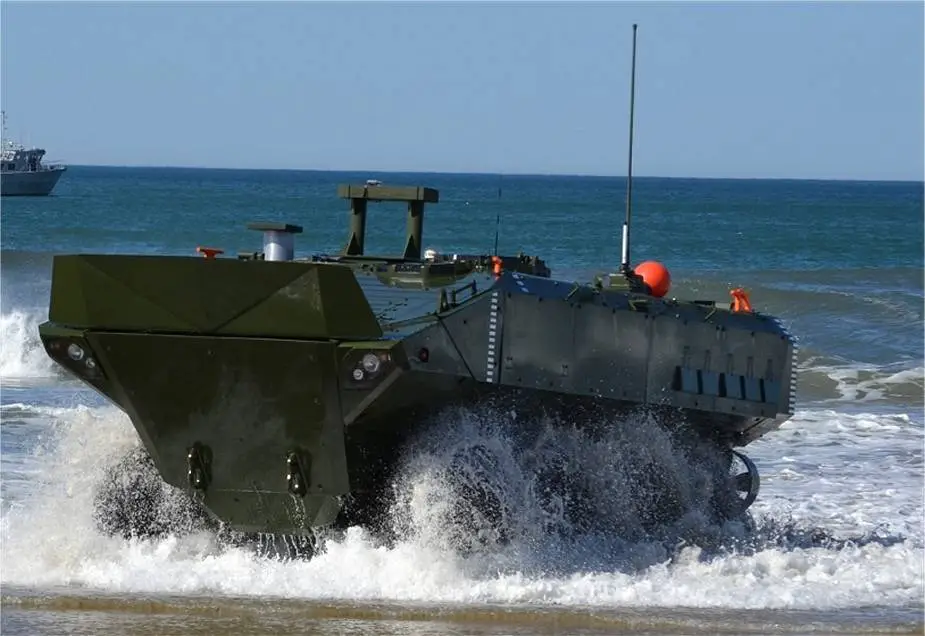3rd U.S Marine Corps Regiment conducted landing operations in Hawai
U.S. Marines with Combat Assault Company (CAC), 3rd Marine Regiment, conduct training exercises at Marine Corps Base Hawaii on May 27 in order to enhance combat readiness and amphibious landing operation proficiency.
Follow Army Recognition on Google News at this link

U.S. Marines with Combat Assault Company, 3rd Marine Regiment, swim ashore in an assault amphibious vehicle during training at Marine Corps Base Hawaii, May 27, 2020 (Picture source: U.S. DoD)
The 3rd Marine Regiment is an infantry regiment of the United States Marine Corps based at Marine Corps Base Hawaii. It falls under the 3rd Marine Division and the III Marine Expeditionary Force.
An amphibious operation is a military operation launched from the sea by naval and landing forces embarked in ships or craft involving a landing on a hostile or potentially hostile shore. An amphibious operation requires extensive air participation and is characterized by closely integrated efforts of forces trained, organized, and equipped for different combat functions. The complexity of amphibious operations and the vulnerability of forces engaged in these operations require an exceptional degree of unity of effort and operational coherence.
U.S. Marines with Combat Assault Company (CAC), 3rd Marine Regiment, swim ashore in an Amphibious Assault Vehicle (AAV) during training on Marine Corps Base Hawaii, May 27, 2020. CAC conducted the training in order to enhance combat readiness and amphibious landing proficiency.
The Assault Amphibious Vehicle (AAV) also called LVTP-7 is a fully tracked amphibious armored vehicle used by the U.S. Marine Corps to conduct amphibious land operations. It is the current amphibious troop carrier of the United States Marine Corps. It is used by U.S. Marine Corps Assault Amphibian Battalions to land the surface assault elements of the landing force and their equipment in a single lift from assault shipping during amphibious operations to inland objectives and to conduct mechanized operations and related combat support in subsequent mechanized operations ashore.

U.S. Marines with Combat Assault Company, 3rd Marine Regiment, operate an assault amphibious vehicle prior to night operations training on Marine Corps Base Hawaii, May 27, 2020.
The first AAV (LVTP-7) production vehicles designated the LVTP7 (Landing Vehicle, Tracked, Personnel, Model 7) were handed over to the United States Marine Corps in August 1971 and the first unit was equipped with the vehicle by March 1972.
The LVTP-7 is characterized by its boat-like bow, its wheeled-tracked system, and slab-sided hull superstructure. The suspension of the vehicle consists of six double-tired wheels with the drive sprocket at the front and the track idler at the rear. The front hull holds a well-sloped raised underside and near horizontal glacis plate leading up to the flat hull superstructure roof.
The LVTP-7 can carry 25 fully equipped personnel who are seated on three bench seats in the troop compartment at the rear of the hull, one in the center and one on either side. The center seat can be removed and the two side ones folded up to allow up to 4,536 kg of cargo to be carried. The removable center seat is stowed on the left bulkhead when not required. The marines enter and leave the vehicle through a power-operated ramp at the rear of the hull, which has a door in the left side of the ramp in case of ramp failure and a single vision block. Over the top of the troop, compartment are three torsion spring-balanced roof hatches.
The LVTP7 is fully amphibious without preparation, being propelled in the water by two water-jets which are mounted one either side of the hull at the rear. The water-jets are driven through right-angled gearboxes on top of the sponsons and drive shafts that extend to the rear of the hull. The vehicle is propelled in the water at maximum forward speed 13.51 km/h and maximum speed in reverse is 7.24 km/h. The tracks can also be used to propel the vehicle when afloat.
The LVTP-7 is fitted with a one-man turret mounted front right side of the hull. The turret is armed with a 12.7 mm heavy machine gun. The latest version, the LVTP-7A1 has a Cadillac Gage turret armed with a Mk-19 40mm automatic grenade launcher and an M2HB 12.7mm machine gun.
In June 2018, the U.S. Marine Corps announced they had selected the BAE Systems/Iveco wheeled Super AV for the Amphibious Combat Vehicle (ACV) program to supplement and ultimately replace the AAV.
The BAE Systems/IVECO ACV is wheeled amphibious armored vehicle able to conduct sea operations in Sea State 3 conditions. The vehicle can carry 13 embarked Marines and three crew with internal storage capacity for all their equipment and two days of supplies.

U.S. Marine Corps Systems Command awarded a contract to BAE Systems to produce and deliver the Amphibious Combat Vehicle.


























